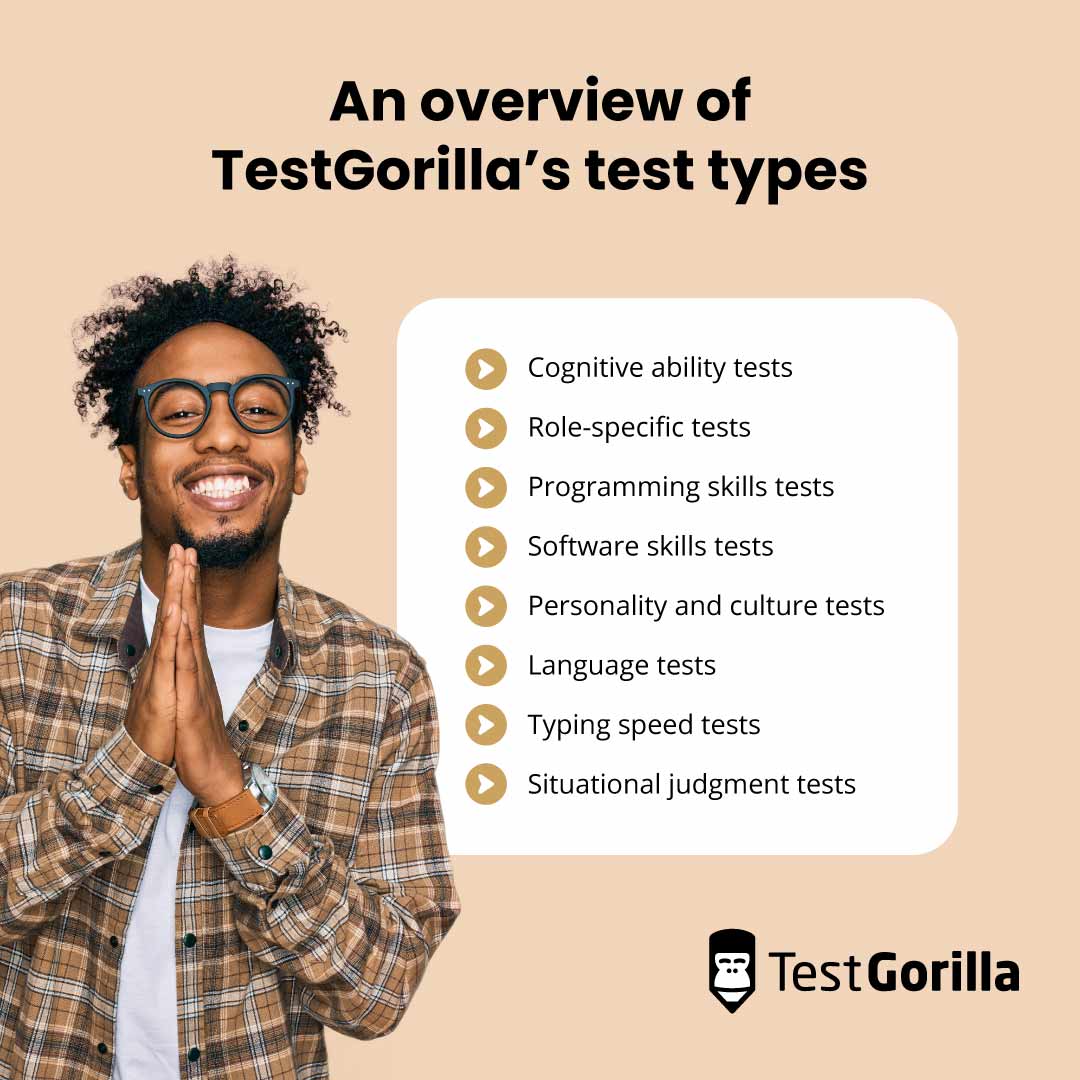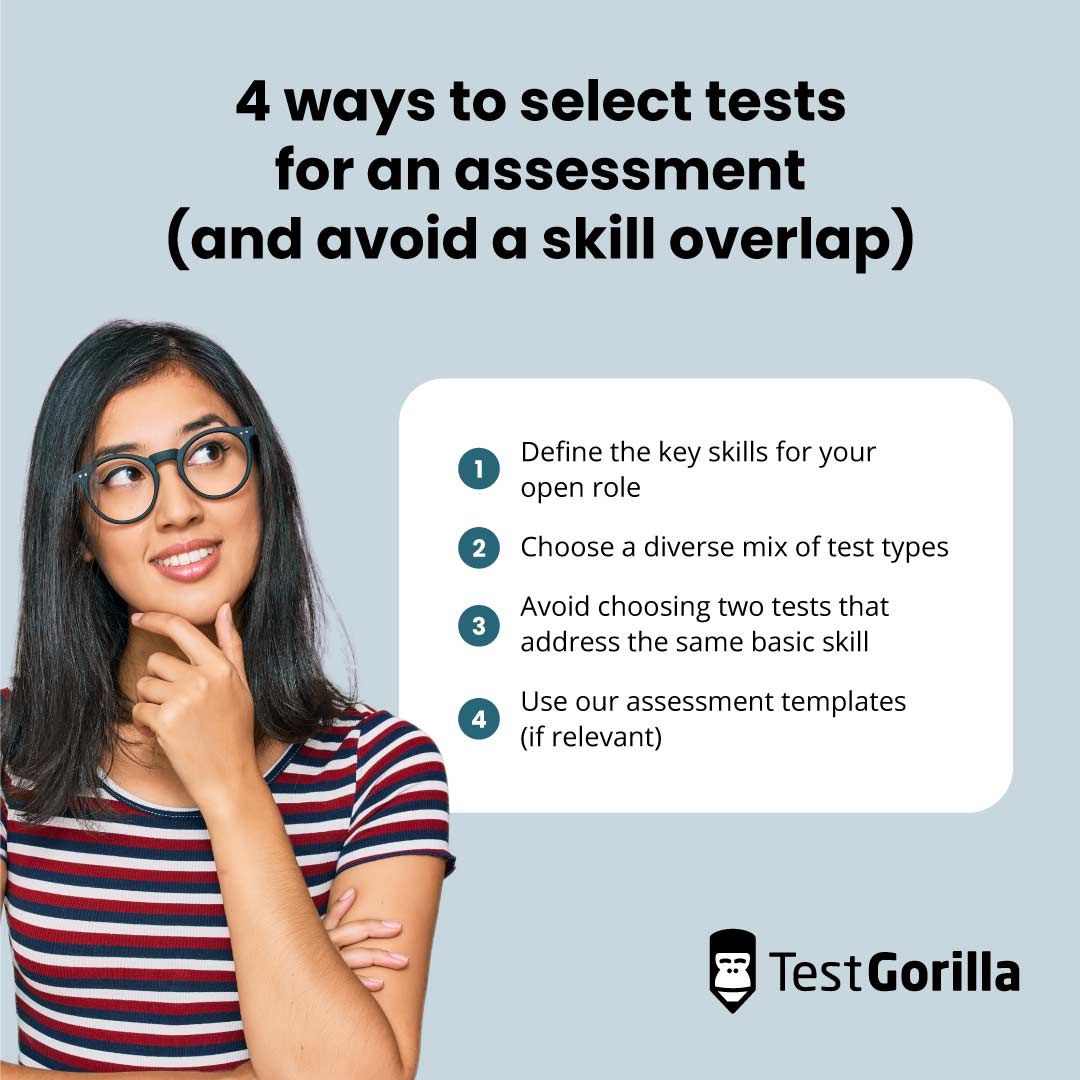How to select tests for an assessment (and avoid a skill overlap)
Science series materials are brought to you by TestGorilla’s team of assessment experts: A group of IO psychology, data science, psychometricians, and IP development specialists with a deep understanding of the science behind skills-based hiring.
If you’re using TestGorilla to create an assessment and you’re seeking guidance in selecting tests, then this is the blog post for you. Read on for concise recommendations from our Assessment Team regarding how to select tests for an assessment – and how to avoid skill or construct overlaps within it.
Table of contents
An overview of TestGorilla’s test types
Before we dive in, here’s a quick overview of TestGorilla’s test types.
Cognitive ability tests
A cognitive ability test is a pre-employment test used to measure a candidate’s cognitive skills. Cognitive ability tests measure a candidate’s mental abilities across a number of different categories; but these tests don’t measure what you know, they measure how you think.
In a strictly literal sense, cognitive ability tests are designed to measure cognitive skills like:
Attention to detail: How closely does a candidate pay attention to detail when processing new information?
Problem solving: How well does a candidate use information to make correct decisions?
Critical thinking: How well does a candidate solve logical problems and think analytically?
Numerical reasoning: How well does a candidate work with and interpret numbers?
Reading comprehension: How well does a candidate understand the key messages in a piece of text?
Spatial reasoning: How well can a candidate understand, remember, and reason about the spatial relationships among objects or space?
These skills have varying relevancies in different job contexts: Numerical reasoning, for example, would be more relevant for an accountant than spatial reasoning. For senior roles, these tests can identify candidates who think on their feet or make complicated decisions with many variables involved. For junior roles, they can help identify high-potential candidates who are quick learners but haven’t had a chance to prove themselves yet.
Role-specific tests
Role-specific skills tests are designed to evaluate a candidate’s ability to perform tasks relevant to a particular job role – for example HVAC technicians, SEO copywriting, merchandise planning, or warehouse picking. These tests are specifically designed to cover the required skills for the role of an HVAC technician, an SEO copywriter, a merchandise planner, and a warehouse picker respectively.
Programming skills tests
These tests measure programming skills like clean code and smart contracts, and test for candidates’ ability to code and debug code in specific coding languages.
There are several ways to evaluate applicants’ programming skills, but having your candidates take a programming skills test is helpful if you’re recruiting as a non-programmer. There are many programming languages out there – including C#, REST API, Express.js, and Ruby on Rails – and our programming skills tests cover debugging in these languages, too.
Software skills tests
Software skills tests evaluate candidates’ abilities to use various types of software. They are widely used because many jobs require employees to use one or more software applications. You can assess your candidates’ abilities to use software such as Hubspot CRM, Google Analytics 4, and QuickBooks Online with our software skills tests.
These tests indicate a candidate’s current skill level in key job-related competencies, but they won’t tell you whether they will be a good fit for the job as a whole. This is why it’s a good idea to combine software skills tests with other test types – but we’ll get on to that later.
Personality and culture tests
Personality and culture tests help you understand how your candidates process information and make decisions.
Personality tests can be open to bias, so it’s important to use them properly (we’ve got some guidance for that). There are plenty of pros and cons to using personality tests for hiring, but here are five things you should keep in mind if you decide to use one:
Avoid basing your hiring decision only on the results of a personality test
Try not to use a personality test after the interview stage
Don’t select an unreliable personality test because it costs less than others
Communicate the purpose of the test with your candidates
Avoid hiring a particular personality type repeatedly based on existing team members
Language tests
Language tests evaluate candidates’ fluency in a specific language. You can find language tests that cover 13 different languages in our test library to varying degrees of proficiency.
These tests covers all four key language skills: Reading, writing, listening, and speaking. They are developed using a widely recognized test framework for languages: the Common European Framework of References for Languages (CEFR).The CEFR levels range from A1 (basic) to C2 (proficient) in each language.
Typing speed tests
A typing test is the best way to hire candidates for clerical skills. It does what it says on the tin – measures how quickly (and accurately!) your candidates can type.
With TestGorilla’s Typing Speed tests, you can hire the best candidates for a variety of jobs, including clerical, accounting, and administrative roles. We have four 2-minute typing speed tests, all of which you can use for free:
Situational judgment tests
Situational judgment is the combination of personal aptitudes and knowledge needed to make a decision, and situational judgment tests can help you understand how your candidates approach certain tasks and situations.
There are various types of situational judgment skills, including business judgment, negotiation, leadership & people management, and business ethics.
The type of situational judgment tests you should use will depend largely on the role you are hiring for. For example, if you’re hiring a business leader, the situational judgment skills specific to this role will likely differ from those required by a teacher or retail assistant. Our guide to situational judgment tests is useful reading to give you more in-depth information about the subject.
Why is it important to avoid a skill overlap?
Successful employees need to utilize all of their skills – from soft skills to technical skills. The tests you select for your assessment should reflect the full range of skills your candidates will be using on the job so that you gain an accurate view of their full skill set – not just a narrow slice of it.
Measuring different constructs that relate to different aspects of job performance makes your assessment be more predictive of a candidate’s job performance. If you end up with a skill overlap, where you’re testing for the same skill more than once, you’re less able to measure this variety of skills and constructs.
How to select tests for an assessment (and avoid a skill overlap)
Next, we’ll take you through how to select tests to create an assessment – so that you can build the best TestGorilla assessment possible for your open role and avoid any skill overlaps therein.
1. Define the key skills for your open role
The first step you should take is to define the key skills for your open role. Having well-defined key skills to begin with sets you up for successfully creating an assessment that tests for job-related skills. If the key skills for your open role are poorly defined, it’ll be more difficult to select tests for your assessment.
2. Choose a diverse mix of test types
An assessment that consists of a diverse mix of test types will provide the best insight into a candidate. As general guidance, no more than two tests from any category should be used in an assessment.
3. Avoid choosing two tests that address the same basic skill
Sometimes, two different tests will address the same basic skill or construct. This is known as a skill or construct overlap, and it happens for a few reasons:
Our role-specific tests are designed to measure a specific set of skills that are crucial for success in the relevant job. These tests are similar to our more general tests, but they provide a more specialized assessment. Because of this, you’ll sometimes see a skill overlap.
Similarly, certain tests in our suite assess a broad skill that encompasses several sub-skills, each of which may also be the focus of individual tests. For instance, our Understanding Instructions test evaluates a candidate’s ability to understand written, visual and verbal instructions. The ability to understand written instructions specifically hinges on reading comprehension – a fundamental component that is also separately evaluated through our Reading Comprehension test.
Additionally, we provide varying skill levels for certain test topics, which may overlap to some degree – especially since someone must be proficient in basic skills to excel in intermediate to advanced skills.
To demonstrate what we mean by this, here are two examples of where a skill overlap might occur:
The Financial Modeling in Excel test covers key role specific advanced Excel skills, so you would not also include the Microsoft Excel (advanced) test in the same assessment. Using both would not provide you with deeper insight into the candidate if you’re hiring for financial modeling skills in Excel.
The Understanding Instructions test and the Reading Comprehension test both address reading comprehension skills (although Understanding Instructions also evaluates a candidate’s ability to understand spoken and visual instructions), because the ability to understand written instructions specifically hinges on reading comprehension. In this instance, you would want to select the test that’s better mapped to the job requirements.
When faced with an overlap, it’s best to choose the test that better reflects the relevant key skill for your open role – which is why defining these key skills is an important first step.
To help with this, reading the test descriptions will provide you with details on the specific skills evaluated in the test (you can access these descriptions via the “Detail” button). In addition, our “suggested test” feature provides a list of tests for specific roles, which you can filter by type; additional tests are listed below the suggestions.
4. Use our assessment templates (if relevant)
TestGorilla has assessment templates available for many roles. These templates are pre-filled with tests that do not overlap, so that you don’t need to worry about testing twice for the same skill or construct.
This being said, our templates aren’t available for every role out there, and organizations might have their own specifics and nuances to a role that our templates don’t cover. So, if you’re creating your own assessment, or even adjusting one of our templates, you should follow the guidance outlined above.
For more guidance on making the most of TestGorilla, read our other Science Series blogs
We have a range of content written by our Assessment team that’s here to help you make the most of skills-based hiring and understand the science behind TestGorilla. Here’s some more recommended reading on the topic of test creation:
Our article on test order introduces the basics of test order and explains the best way to approach the way you order tests within an assessment.
Our article on candidate satisfaction explains why candidate satisfaction is important and how we measure it at TestGorilla, as well as offering some steps our customers can take to improve candidates’ satisfaction with their assessment experience.
Related posts
Hire the best candidates with TestGorilla
Create pre-employment assessments in minutes to screen candidates, save time, and hire the best talent.
Latest posts
The best advice in pre-employment testing, in your inbox.
No spam. Unsubscribe at any time.

Hire the best. No bias. No stress.
Our screening tests identify the best candidates and make your hiring decisions faster, easier, and bias-free.
Free resources
This checklist covers key features you should look for when choosing a skills testing platform
This resource will help you develop an onboarding checklist for new hires.
How to assess your candidates' attention to detail.
Learn how to get human resources certified through HRCI or SHRM.
Learn how you can improve the level of talent at your company.
Learn how CapitalT reduced hiring bias with online skills assessments.
Learn how to make the resume process more efficient and more effective.
Improve your hiring strategy with these 7 critical recruitment metrics.
Learn how Sukhi decreased time spent reviewing resumes by 83%!
Hire more efficiently with these hacks that 99% of recruiters aren't using.
Make a business case for diversity and inclusion initiatives with this data.






















